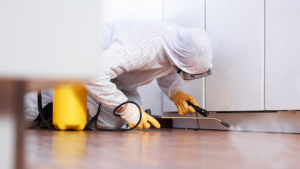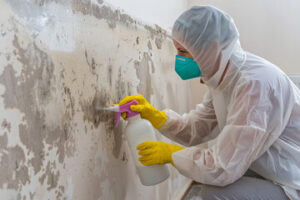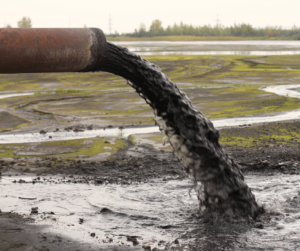Pests damage plants, crops, and animals and may also be dangerous to people, pets, and livestock.
Preventive measures reduce the number of pests and their damage. Examples include removing food and water sources, fixing leaky plumbing, and storing garbage in sealed containers. Contact Pest Control Bakersfield CA now!

Biological control uses natural enemies of a pest, such as predators, parasites, and pathogens. Sometimes, these are bred in the laboratory and then released in the field.
Prevention
Pests are organisms that damage property, contaminate food or threaten human or animal health. They include insects, rodents, birds and other vertebrates that damage crops or eat livestock, as well as plants, diseases and pathogens (fungi, bacteria and viruses).
Preventing pest problems is the most desirable means of managing them. This involves eliminating conditions that favor them, such as blocking entry points into buildings and removing food and water sources. It also includes sanitation practices, maintenance of proper moisture levels and use of preventive chemicals.
Using threshold-based decision making, it is generally appropriate to control a pest only when it causes unacceptable harm. Thresholds are established by evaluating the condition of the pest’s habitat, the number of pests found and their rate of increase over time. It is often difficult to accurately determine pest numbers, so scouting and monitoring are necessary for effective management.
Prevention strategies are often less expensive than the cost of controlling a large outbreak after it occurs. These include:
The most common method of preventing pests is to reduce their access to food, water and shelter. This can be done by keeping garbage in tightly-covered containers, storing pet food and litter in sealed bins, maintaining good sanitation habits and caulking cracks and crevices. It is also important to eliminate any places that can be used for nesting, such as stacks of hay and other debris, and to keep wood structures properly maintained.
Another way to prevent pests is by using biological controls, which are bacteria, fungi or other organisms that kill or debilitate their hosts without harming people, pets or other non-target organisms. For example, the bacterium Bacillus thuringiensis produces a toxin that destroys the midgut of caterpillars and other Lepidopterans. It is available in formulations to manage over 400 insect species without harming people or their pets.
Many preventive steps can be taken on the homeowner’s own, although it is sometimes helpful to consult with a pest control specialist to learn about options that are specific to a particular problem. Regular inspections can spot potential infestations early and help homeowners establish a “watch list” of pests to monitor for signs of a serious problem.
Suppression
Pest control is the process of reducing pests to an acceptable level. This is accomplished through a combination of prevention and suppression strategies.
Preventing pests from entering your home or business is the best way to keep them away for good. This includes keeping food in sealed containers and removing trash regularly. In addition, it is important to repair leaky pipes and fix clogged drains so that water does not attract pests. It is also a good idea to use a pest deterrent spray for outdoor plants. This will make the area unpleasant for the pests and they will move on to another plant or house.
Insects are a major nuisance and cause damage to property, crops, and gardens. They can also transmit diseases to people and pets, such as rabies, leptospirosis, salmonella, tularemia, and hantavirus. They may bite or sting, or cause allergies and sensitivities, such as with bees, wasps, hornets, termites, cockroaches, silverfish, earwigs, and cluster flies. Pests can also destroy fabrics, eat or stain food, and ruin garden areas and personal belongings.
Some natural forces affect pest populations, including climate, the presence of natural enemies, natural barriers, availability of food and water, and shelter. Other factors that influence pest populations include genetics, pheromones, juvenile hormones, and nematodes. Biological, chemical, cultural, mechanical and physical controls are used to manage pests.
Integrated Pest Management (IPM) is an ecosystem-based strategy that utilizes preventive measures such as environmental manipulation and modification of cultural practices to manage pests before they become problems, and uses monitoring and intervention when necessary to control pests that have already developed. Chemicals are only used when monitoring indicates that they are needed, and treatments are made with the goal of removing only the target organism while minimizing risks to humans, beneficial insects, and other nontarget organisms.
Choosing the right pest control company for your home or business is essential. You should look for a company that has a proven track record of providing effective services and is licensed, insured, and certified. You should also choose a company with tenured employees because they will have the experience and knowledge to understand your unique situation.
Identification
Identifying pest problems, and their causes, is often critical to successful pest control. Pests may be more than just a nuisance: they can bring diseases to people, livestock, and crops; contaminate food; damage structures and buildings; or disrupt ecosystems. In addition, a wide variety of pests can cause direct economic loss, and some, such as cockroaches, rodents, and bed bugs, are known to trigger asthma attacks, allergies, and other health problems in humans.
An integrated pest management (IPM) approach to pest control combines several appropriate tactics into a plan to reduce pests and their damage to an acceptable level. Control tactics can include host resistance management, biological control, cultural control, mechanical control, sanitation, and chemical (pesticide) control.
IPM strategies typically minimize the use of pesticides, which can lead to pest resistance and have other adverse environmental impacts. IPM also stresses the importance of prevention, which requires routine scouting and monitoring for pests, including inspection of the environment around buildings and sites, as well as identification of potential infestation areas.
For example, if you suspect possums are living in your roof, or that there are cockroaches nesting under your home’s sinks, the first step is to listen for sounds of rodent activity. Scratching, squeaking, and scuttling can be audible, especially at night when the pests are most active. Listening for these sounds is particularly important in urban settings, where noise pollution tends to obscure natural rodent sounds.
A visual check of the interior of your house, garage, or basement for signs of pests is another important aspect of prevention. Look for droppings, egg shells, and other signs of pest presence, and take note of the location of these signitures – are they near food sources such as kitchen sinks or trash containers?
Scouting and monitoring for pests is usually done on a regular basis, from daily to weekly depending on the environment and the pest in question. Routine monitoring allows the identification of a problem before it becomes a major issue, and helps to limit the amount of pesticide needed for a successful application.
Treatment
When pest populations are allowed to build up to damaging levels, control measures may be needed. These may include scouting, monitoring, trapping and the use of herbicides, insecticides, or other chemicals. Treatment strategies are usually part of an integrated approach to pest management, often referred to as IPM (integrated pest management). When using any chemical, it is important to read and follow the label instructions carefully in order to ensure that only the target organism is affected. Non-target organisms, such as beneficial insects and birds, should also be considered when deciding on the proper application rate of any pest control product.
Prevention is the first step in controlling pests, but some situations call for suppression or even eradication. In outdoor settings, eradication is rare and usually reserved for situations in which an introduced pest has a direct impact on agricultural or economic interests. For example, invasive species such as Mediterranean fruit flies and gypsy moths are usually controlled through a combination of suppression and prevention measures in urban and commercial areas.
Predator and parasite populations are the primary means of keeping many plant-feeding pests under control in natural ecosystems. However, these organisms do not work in isolation, and the abundance of a particular predator or parasite depends on the availability of food sources. In lawns, for example, a few yards can have abundant millipedes or grubs while the same yard two houses away has few.
Likewise, weather conditions can affect pest numbers. For example, a drought can decrease the population of some insect pests by depriving them of their food source. Other environmental factors can also limit pests, including the availability of water, shelter, and overwintering sites, as well as the presence of competitors or other predators.
Homeowners can help reduce the need for treatment by making their property less attractive to pests. Remove brush and debris that can provide hiding places for pests. Eliminate weeds that compete with plants for water and nutrients. Clutter can give pests a place to breed and hide, so get rid of piles of newspapers or other materials where pests might lay eggs. Caulk cracks and crevices to prevent entry into structures where pests can live and feed.








